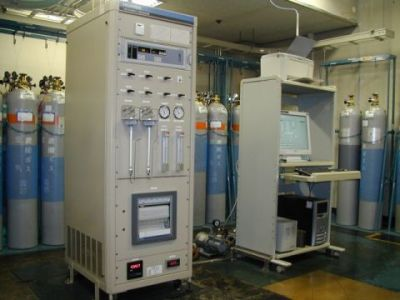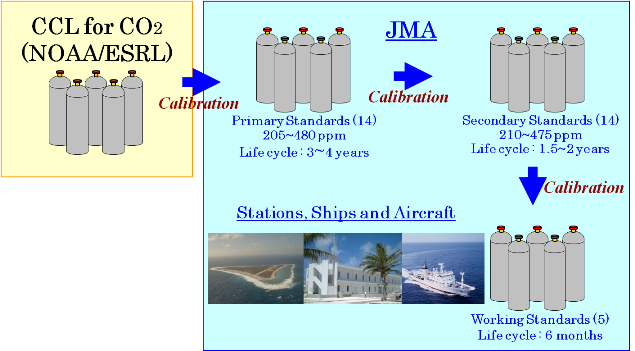Calibration for atmospheric cabon dioxide observation
JMA operates a carbon dioxide (CO2) calibration system to maintain CO2 standard gases with three ranks.
JMA standard gases
JMA primary standard gases
In the first rank of gases on which JMA's CO2 observations are based, the primary standard gases for CO2 are stored in 14 cylinders with concentrations ranging from around 200 to 480 ppm. This range covers a wide variety of observations, both oceanic and atmospheric. The cylinders used to store the gases, which are mixtures of CO2 and natural air, have a volume of 48 liters and are made of aluminum alloy to minimize drift. The concentrations of the primary gases were determined accurately against the WMO reference standard gases maintained by NOAA/ESRL before use (Zhao and Tans 2006) . The standard scale is called WMO X2007, and assures the international traceability of JMA's observations.
JMA secondary standard gases
In the second rank, the secondary standard gases for CO2 are stored in 14 cylinders with a concentration range similar to that of the primary standard gases. As the primary standard gases are important in securing consistent observations by JMA, the same ones should ideally be used for as long as possible. To this end, the lifetime of these gases is prolonged by introducing secondary standard gases to reduce their usage. The secondary standard gases are also kept in 48-liter aluminum cylinders, and their concentrations are determined using the CO2 calibration system at JMA Headquarters based on the primary standard gases.
JMA working standard gases
In the third rank, the working standard gases used by observation stations, vessels and aircraft are stored in five cylinders with concentrations set in accordance with the respective observational objectives. The concentrations of the working standard gases are determined using the CO2 calibration system based on the secondary standard gases, and these working standard gases are then sent out to individual stations and vessels. After use in observation, the gases are sent back to JMA Headquarters to be checked for drift, and the concentrations are compared with those of the secondary standard gases (see Atmospheric carbon dioxide observation ) .
Monitor drift of the standard gas concentrations
Standard gases must be compared with higher-rank standard gases on a regular basis to monitor drift. However, as it is inefficient to make different ranks of standard gases available at the same time very often, standard concentrations may occasionally be mutually monitored using standard gases of the same rank in a process called self-calibration. The typical drift of a single cylinder can be monitored in this way. JMA carries out self-calibration frequently for primary and secondary standard gases to monitor their precision between instances of comparison with higher-rank standard gases. In 2004 and 2011, previous calibration records were organized and reviewed. All concentrations of primary standard gases recorded since the beginning of observation were revised in a unified manner by correcting for differences in concentration at the time of gas replacement (JMA 2003, Matsueda et al. 2004, Tsutsumi et al. 2005) . The primary standard gases currently in use, which were calibrated in October 2010 at NOAA/ESRL, are the seventh generation since observation was started.
Calibration syatem
The calibration system for CO2 concentration is configured via non-dispersive infrared spectroscopy (NDIR: Horiba, Ltd. VIA510R) as with the observation system. As the calibration system is not used to analyze actual atmospheric air, gases for analysis are simply dried using magnesium perchlorate (Mg(ClO4)2) . The 15-minute mean standard deviations indicating observation system stability do not exceed 0.02 ppm. The difference between two runs of the above stability test indicates repeatability, and is within ±0.02 ppm.
|
Figure 1: CO2 calibration system at JMA headquarters |
|
Figure 2: JMA Calibration architecture for CO2 standard gases |
References
Tsutsumi, Y., H. Matsueda, S. Nishioka, 2005: Consistency of the CO2 primary standards in JMA, 12th WMO/IAEA meeting of experts on carbon dioxide concentration and related tracers measurement techniques (Toronto, Canada, 15-18 September 2003) , Global Atmosphere Watch Report No. 161, WMO/TD-No. 1275.
Zhao, C. L., and P. P. Tans, 2006: Estimating uncertainty of the WMO mole fraction scale for carbon dioxide in air. J. Geophys. Res., 111, D08S09, doi:10.1029/2005JD006003.

